BARRINGTON, N.J., Oct. 3, 2006 -- In 1942, Norman W. Edmund had a hard time finding a lens he needed. So he did what any frustrated amateur photographer would do: published a surplus optics catalog. A year later, he mailed 12 stapled pages comprising the first Edmund Optics Catalog to 200 like-minded people.
From the 1950s through the 1970s, the Edmund Catalog operated under the name Edmund Scientific Corp. as a supplier of chipped lenses, war-surplus optics and low-cost scientific gadgetry. According to The Last Whole Earth Catalog, "Its advertisements in publications like Scientific American caught the attention of hobbyists, amateur astronomers, high-school students and cash-strapped researchers. During four decades Edmund Scientific was virtually unique and was of cultural importance in the lives of young and old scientific hobbyists."
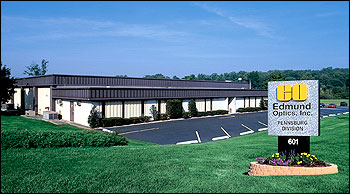
Edmund Optics manufacturing facility, Pennsburg, PA
EO's manufacturing capabilities, combined with its global distribution network, has made it the largest supplier of off-the-shelf optical components. Led by a staff of skilled optical engineers and scientists, EO is application-focused and pursues new ways to implement optical technology, enabling advancements in semiconductor manufacturing, industrial metrology and medical instrumentation.
"Our precision products improve efficiencies and yields and are used in test and measurement quality assurance applications, the automation of manufacturing processes and research," according to the company's Web site.
Along with its Arizona research & design center and Pennsylvania manufacturing facility, EO has its original manufacturing plant and corporate headquarters in Barrington, N.J., and sales offices, procurement offices, manufacturing facilities (or representatives) in Japan, China, Germany, the UK, Singapore, Israel and Switzerland.
Its capabilities include:
- High-precision magnetorheological finishing for lenses and prisms
- Stock and custom coatings up to a 130-layer design
- Optomechanical assemblies
- Optoelectronic assemblies
- CNC (computer numerically controlled) lens grinding and polishing
- CNC (computer numerically controlled) metal machining
- Precision CCD optics
- Optical component manufacturing (0.5 to 100 mm diameter
- Flat, spherical and parabolic mirrors
- Prism manufacturing (0.5 to 75 mm)
Its facilities feature equipment including:
- Qed technologies q22-y magnetorheological finisher (mrf)
- Digital optical design workstations
- Zygo gpi-xp4 phase shift interferometers
- Trioptics test equipment
- Optotech grinder
- Optotech polisher
- Strasbaugh four spindle polisher
- Strasbaugh 10j edge grinder
- Saida centering machine
- Yoshikawa generator
- Universal drapers
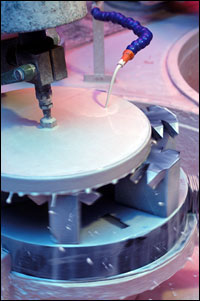
Contact block polishing
EO didn't grow single handedly, though. In the 1940s, Norman Edmund worked with a close friend, John Plummer, at the Franklin Arsenal in Philadelphia. They ultimately developed a business relationship around optics. Plummer set out to build a full-scale optical manufacturing plant in Pennsylvania, identifying Asian partners and global resources to support his efforts.
The Plummer operation blossomed into a high-volume, custom military facility by the late 1980s, employing over 200 people in Pennsburg, Penn., and 50 in Singapore. Plummer was a pioneer and innovator in the automation of optical production, and his facility in rural Pennsylvania was for many years viewed as the model of US technology and efficiency in the industry.
During the same timeframe (1950s-1990s), Norman Edmund developed the Edmund Optics catalog, reaching thousands of young scientists throughout the US and inspiring an interest in optical technology. The Edmund business also grew, ultimately focusing on industrial sales. After joining his father at the company in the late 1970s, Robert Edmund developed a business relationship with Plummer. They joined forces to develop EO’s first line of Tech Spec optics in 1987. The Plummer operation directly supported the Edmund Optics catalog and large-volume efforts, offering new technologies as well as products only master opticians could create.
Robert Edmund started out at Edmund Scientific as accounting and personnel manager, working alongside his parents until they retired in 1975. As president, Robert eventually reorganized the company into two divisions: Consumer Science and Industrial Optics. (The Consumer Science Div. was sold in 2000 to Science Kit.) He is currently CEO of Edmund Optics and chairman of its board. A graduate of Georgetown University’s School of Business, he served as Chairman of the Board of the Direct Marketing Association (DMA) in 1996. Currently on the board of Stewart Labs at the University of Arizona, he is widely regarded as an expert in the photonics and optical technology industries.
The Plummer plant slipped from its envied position in the 1990s when Plummer was diagnosed with cancer. The company suffered a setback with some of its military customers, and investment in new operations was minimized. Plummer died in 1997, and a replacement manager was brought in to position the company for sale.
Given the long friendship and business relationship between the families, Robert Edmund said, this was a logical opportunity for Edmund Optics to purchase the Plummer plants in the US and Singapore and to continue John’s legacy of innovating optical manufacturing technologies.
"I am quick to admit that it took more time and money than ever imagined to bring the facility back to life in today’s global economy," Robert said. "The obstacles to restoring the plant were many, but perhaps most difficult was creating a team of manufacturing and engineering talent and recruiting them to the location."
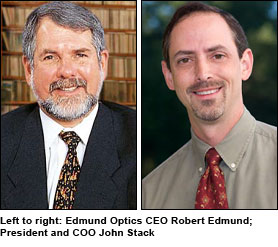 EO refocused on industrial optics during the mid-1980s when market analysis showed that demand for its educational items had peaked. Since that time, it has become well known as a catalog-based distributor of industrial optics and related products, as well as a source for application integration, custom lens and coating design and OEM services.
EO refocused on industrial optics during the mid-1980s when market analysis showed that demand for its educational items had peaked. Since that time, it has become well known as a catalog-based distributor of industrial optics and related products, as well as a source for application integration, custom lens and coating design and OEM services.
In 2004, with the help of an Edmund Optics board member, the late Harvey Pollicove, EO recruited Walt Czajkowski from Kodak Inc. to drive EO’s manufacturing efforts at the Pennsburg facility. Optical engineers were pulled in from EO’s New Jersey and Arizona locations to fill key openings and to complement talent already in place. Pollicove had led the Kodak manufacturing team that developed and implemented a lens-fabrication process that allowed the creation of disk cameras, and later he helped develop a similar process that led to better optics in CD players. In 1990, Pollicove retired from Kodak to join the University and establish the Center for Optics Manufacturing (COM) with Duncan Moore, who was at that time the Director of the Institute of Optics. The center researchers design methods to produce lenses and other optical components that are traditionally difficult or impossible to create. Pollicove helped and advised numerous optical companies during his tenure at COM.
"The team today is tight and cohesive," Czajkowski said. "They understand our goals and the targets leading to success."
Also on EO's executive team is its president and COO, John Stack, a veteran engineer, technology expert and business development leader. He has overseen the rapid growth of Edmund Optics’ facilities around the world in more than six countries including Singapore, Germany and Japan. He spearheaded the addition of over 85,000 sq. ft. of global manufacturing space and sales and engineering facilities throughout the world.
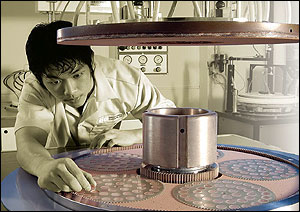
Double-sided polishing
Stack further expanded EO’s production capabilities to include not only component-level optics, but also imaging and optomechanical assembly technology, by investing in a wide variety of optical manufacturing technology such as aspheric polishing, precision glass molding and advanced optical coating. Stack is on the board of the Automated Imaging Association (AIA) and was its president from 2003-2004. He also holds a board position on the Automated Technology Council that oversees the AIA and Robotics Industry Association. He serves on the industrial advisory board for the New Jersey Institute of Technology (NJIT) and speaks frequently on imaging and photonics technology around the world.
Samuel Sadoulet, corporate director of engineering, began his career with Edmund as an applications engineer. One of Edmund's youngest senior-level corporate managers, he has made several key technology contributions in the areas of high-speed MTF metrology, integrated telecentric imaging systems, LED illumination technology nd numerous image-based optical systems.
Touring the Pennsburg facility today, Czajkowski proudly points out the new Schneider aspheric grinding generators, the QED MRF machines and the new Toshiba glass molding station. He explains the importance of EO’s advanced metrology equipment and offers a lesson on the Taylor Hobson profilometer and the Zygo interferometer. He also demonstrates how the entire operation is scheduled using EO’s new ERP system, Made2Manage.
"The investments are paying off, the staff is well-tuned, and the customers want what the reinvented plant has to offer -- the most advanced technologies for optical manufacturing in the US," Robert Edmund said.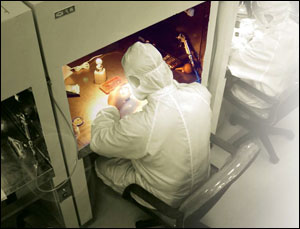
Clean assembly station, Shenzhen, China
"It is a story of two families in optics and it is a legacy founded on technological excellence," he said. "Anyone who knew John Edmund would be proud to see his plant today. And anyone who has struggled to breathe life into a family business will appreciate the sacrifice and persistence required to persevere in any industry."
In its August annual report to shareholders, Edmund Optics reported 13 consecutive quarters of year-on-year sales growth. The latest quarter marked a 10.6 percent increase in consolidated revenue in 2005 and a 5 percent improvement in profitability.
With new sales offices, distribution centers and manufacturing facilities throughout the world, Robert Edmund said, EO is "the largest supplier of off-the-shelf optical components. Supporting this statement is Edmund’s extensive global inventory, totaling over $12 million with more than 11,000 unique SKUs (stock-keeping units).
EO reported a 113.9-percent increase in research and development expenses, with significant advances in LED illumination technology, large-format imaging lenses and precision reflective microscope objectives. The company also stated significant investments in its global manufacturing equipment, with specific emphasis on aspheric generation and polishing in order to supply both standard and custom aspheres for a variety of markets including the US military.
Edmund said the company's new Shenzhen, China, manufacturing and design center will play a greater role in 2006 as it continues to expand its own line of optomechanical assemblies and illumination devices.
New this year are EO's EOS high-efficiency illumination technology, which harnesses the power of LEDs, which is being implemented in the form of a fiber optic illumination source as a first product release; however the technology is not limited to this delivery mode. The technology is optically based, taking bare LED dies, coupling the 2-pi distribution in a very efficient manner, multiplexing them with similar or specified wavelength sources and delivering the energy with extreme efficiency to a fiber. The illumination is flat-topped in intensity profile, has both near- and far-field uniformity correction and can be direct-voltage driven or strobed. The initial offering has three channels (RGB); each channel can be controlled independently.
EO also recently teamed up with Braas Co., Epic Vision Systems, Minarik Corp., Wineman Technology Inc. and other system integrators to provide customers with complete machine vision and factory inspection solutions. Termed Vision Integration Partners (VIP), the team provides on-site vision system integration services throughout North America. Recent projects EO has completed with VIP team members include material verification for the pharmaceutical industry, semiconductor component inspection, automotive part compliance and packaging inspection for the food-and-beverage industry.
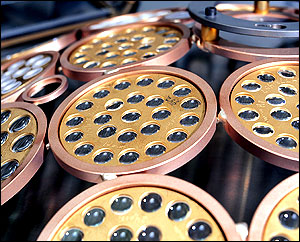
Antireflecton coating
This year, the company also installed an advanced aspheric manufacturing cell at its Pennsburg facility; expanded its coating capabilities in the US and Asia; built a new cleanroom assembly site in Shenzhen; and introduced new laser accessories, reflective objectives, filters and beam expanders
The Department of Defense recently awarded EO $2.8 million in ManTech funding for the development of advanced manufacturing tools critical to producing complex conformal and advanced optical elements such as aspheres. Geared primarily at advances in precision glass molding technology, the initial objective will be to create low-cost tooling methods critical to low- and mid-volume lens production runs needed by many DoD programs. As the program unfolds over the next two to three years, the scope will be expanded to include new methods for reducing assembly time of complex optical systems such as high-precision night vision and fire control systems. EO, in conjunction with the US Army Benet Weapons Lab, will manage the project at its Pennsburg facility. Design engineering and assembly technologies will be codeveloped at EO's headquarters in Barrington and its design center in Tucson.
Company officials said they view the funding as a critical step in regaining the lead on critical optics manufacturing technology that has been lost over the years to foreign companies while at the same time creating highly skilled jobs for both Pennsylvania and New Jersey.
EO is also proactive in supporting optic education efforts. It employs several engineering interns every semester and during summer breaks. Internships are available at every EO domestic location, as well as for specific projects at global offices. A variety of full-time positions are available to graduating students in every EO department and worldwide. The company also sponsors several scholarships and Excellence in Optics awards at schools such as the University of Rochester, the Rochester Institute of Technology, the University of Arizona and the New Jersey Institute of Technology. It works with several universities on collaborative research projects as well as product design and testing.
For more information, visit: www.edmundoptics.com